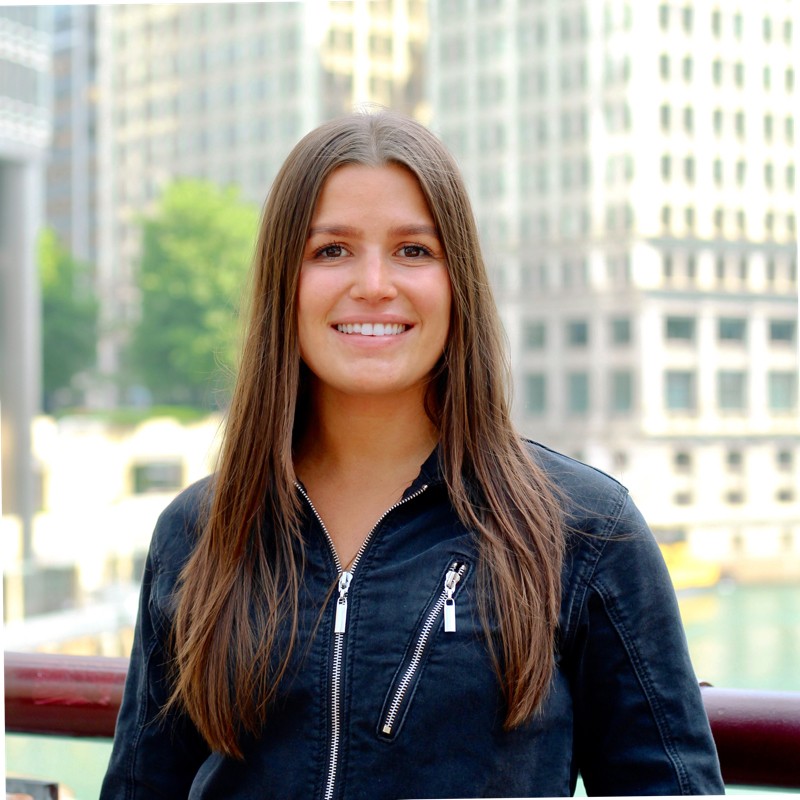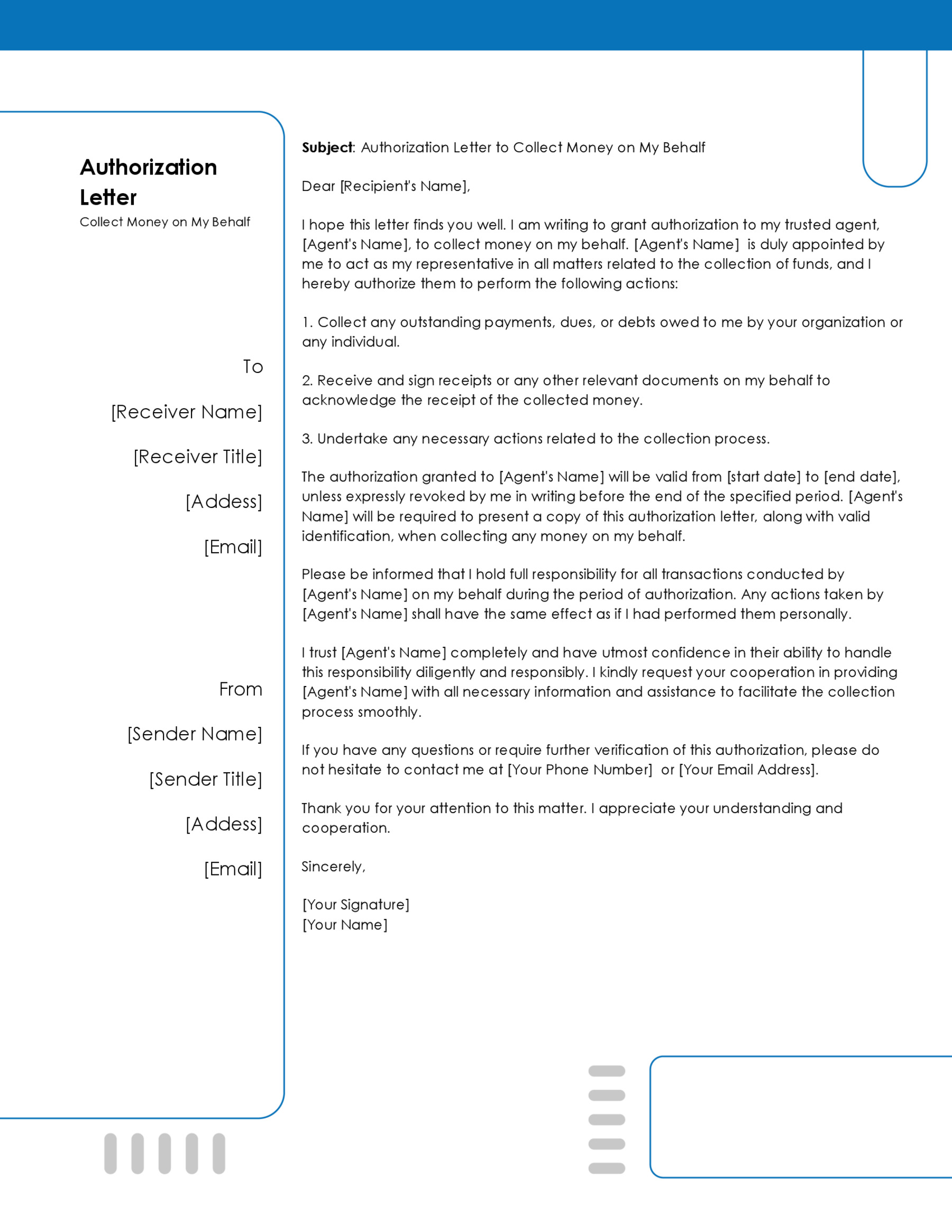A cover letter is an important document that should be included with all resumes. It quickly introduces you to a potential employer and convinces the hiring manager that you will be a suitable candidate for the job.
In this article, we will discuss the following:
- What is a cover letter?
- The different sections within it.
- How to effectively write one?
- Some tips and tricks for writing it effectively for a resume.
What is a Cover Letter?
It is a one-page document addressed directly to the hiring manager. In just 3 or 4 paragraphs, you will explain why you are interested in the job, highlight your skills, and demonstrate why you are qualified for the specific role. The purpose of the letter is that it should effectively distinguish you from other candidates.
The letter must not be generic but customized for each company to which you apply. The document is crucial because it is your first chance to stand out among the many applicants. For this reason, you will want to do some research before writing to show yourself as a dedicated candidate.
Samples for Cover Letter
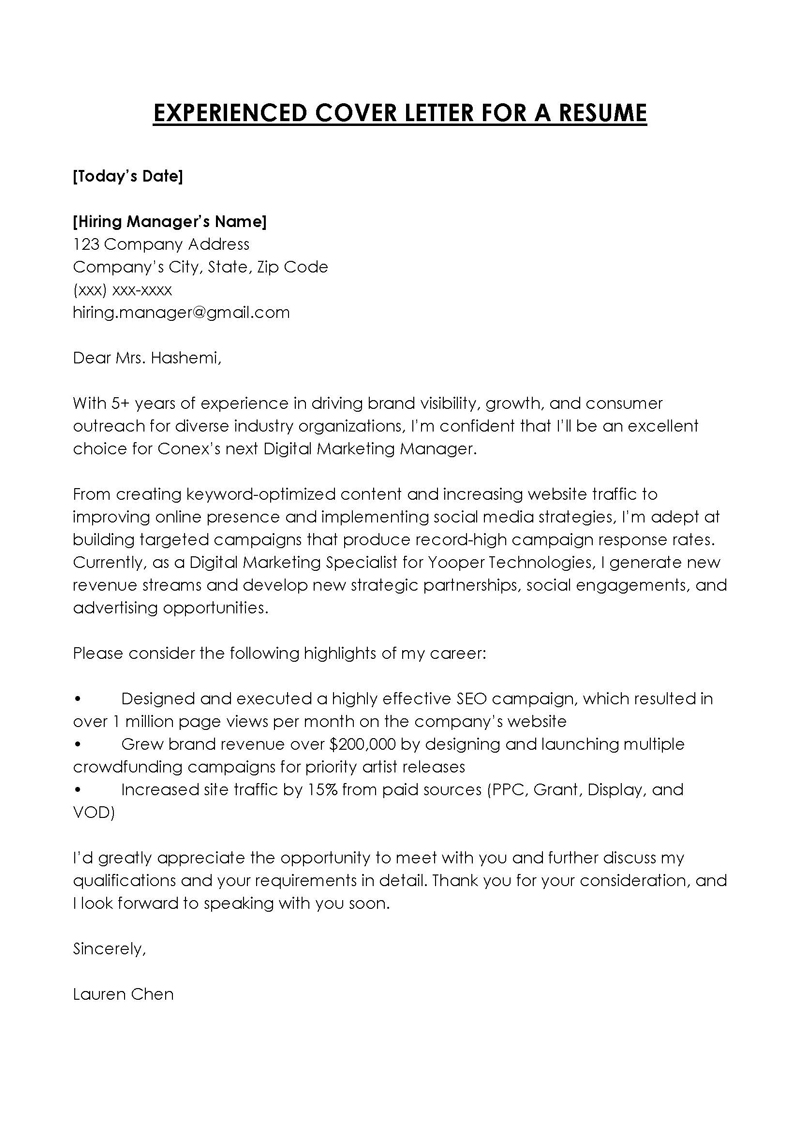
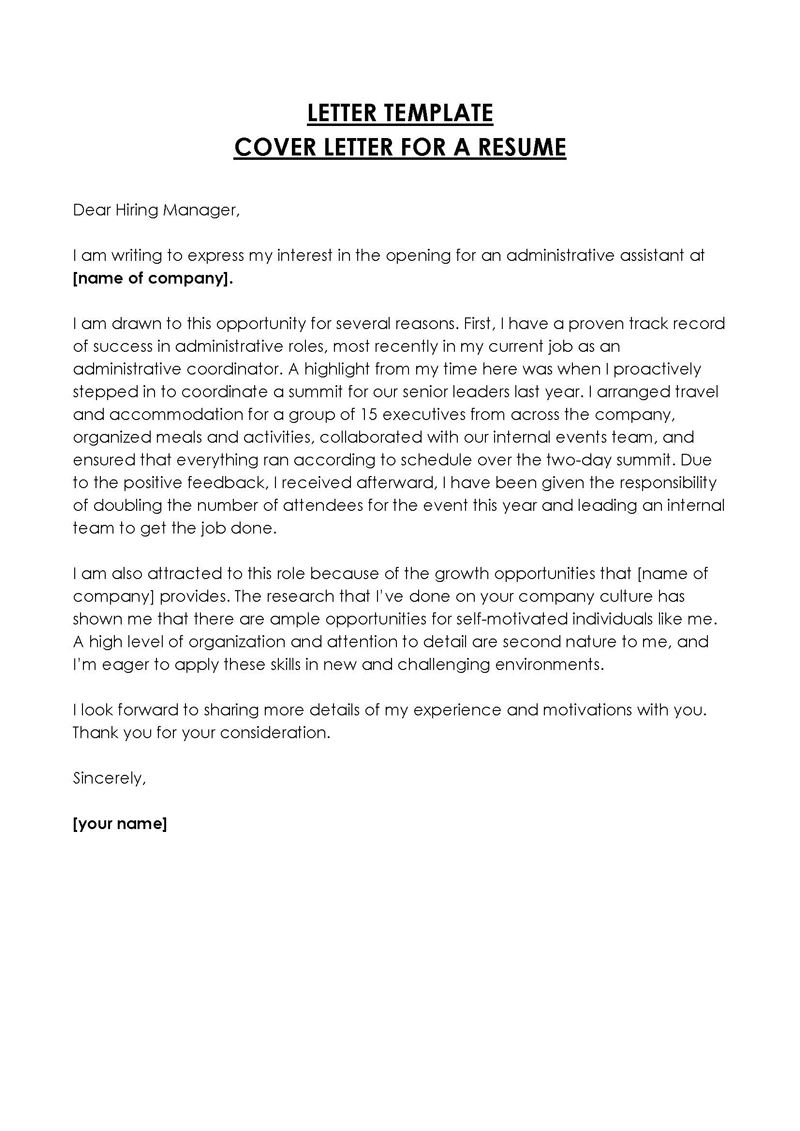
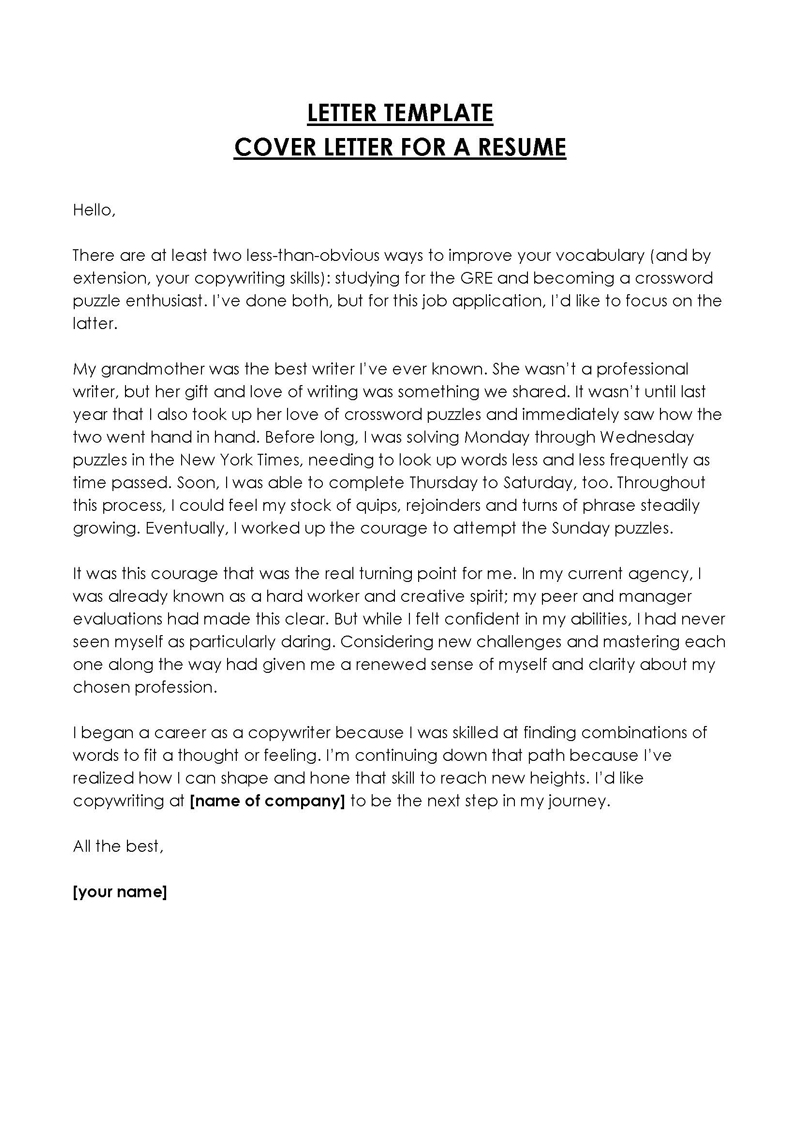
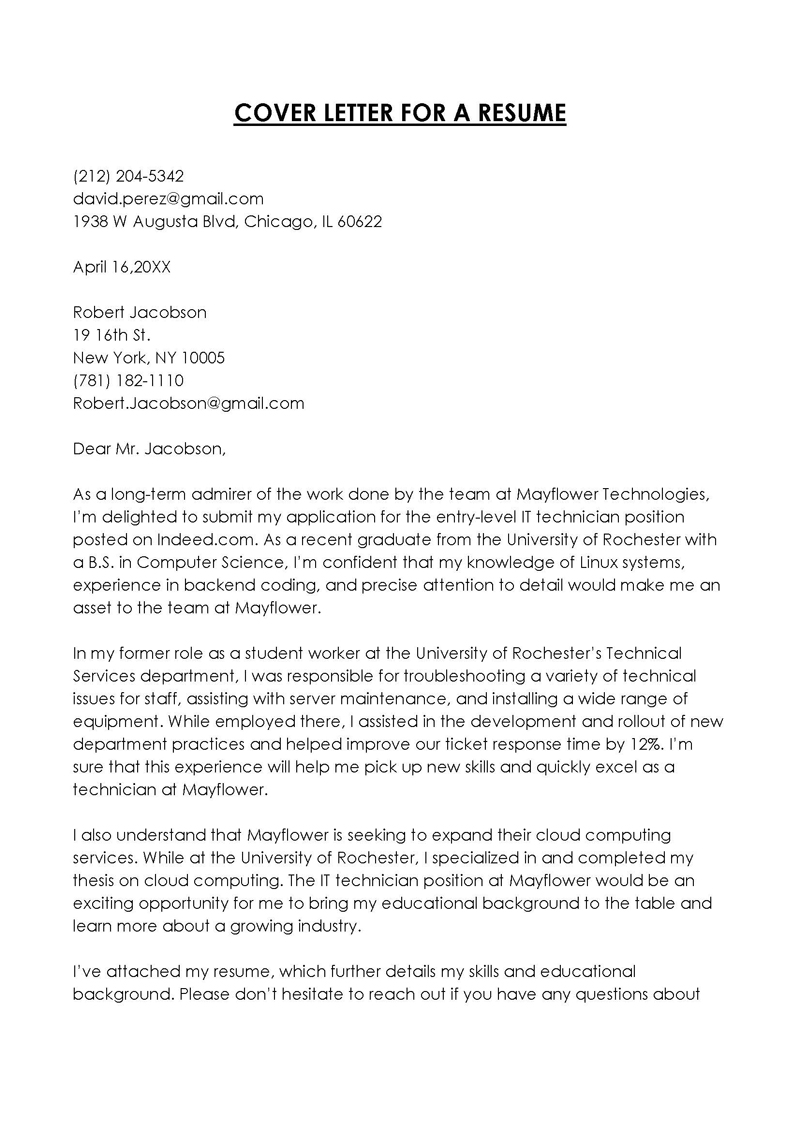
How Do I Write a Cover Letter?
There are several standard formatting rules you must follow for the letter. This keeps your letter tidy, professional, and easy to read.
These rules are:
- Keep it to 200-350 words long.
- Use single-line spacing.
- Only use standard fonts like Arial, Calibri, or Times New Roman.
- A readable font size of 10.5–12 points is recommended.
- If you are printing the letter, the only formats that are acceptable are US or A4 page sizes.
- Leave margins between 1″ and 0.5″ on each side.
- For the main content, left alignment is recommended.
Sections of the Cover Letter
You should write it using a standard format and content since such letters for resumes frequently follow a similar pattern. This is important so that your future employer is impressed with your professionalism, which will increase your chances of obtaining the job.
The following are the different sections you should include:
Professional heading
The most appropriate professional heading for your cover letter includes the contact details of both you and your potential employer.
This means you should include the following:
- Your full legal name
- A professional email address
- A phone number
- Your mailing address (if relevant)
- LinkedIn profiles or portfolio websites
After all your contact information is included, you will also include information about the company or business to which you are sending the job application.
- The date
- The first and last name of the recipient
- Company address
- Company phone number
- Email address of the recipient
Addressing the hiring manager
The section after the heading is formal salutations and greetings, where you will address the person you are writing to. The best approach is to directly address the hiring manager. In this case, a formal salutation is appropriate.
EXAMPLE
You can say “Dear Ms. Smith” or “Dear John Doe.” This demonstrates that you have made efforts to find the relevant person’s name and have already researched the company. Additionally, it gives a personal touch to your letter, enhancing your standing.
NOTE
There are several ways you can find the hiring manager’s name if it is not obvious. The simplest solution is to check the job posting to see if it is mentioned there. Usually, the organizations have the names of their team members on their websites. You can search the company’s website or LinkedIn page to see if it lists its name. If you cannot find the name via these methods, an appropriate way to handle the situation would be to contact the HR department and ask for the name of the specific hiring person.
Introduction
Your introduction should be concise, clear, and direct. This way, the reader immediately knows the purpose of the document.
There are three main sections to include in your introduction paragraph:
Name of the job position and the company
In the first sentence, you should be directly and clearly stating the position you are applying for. Huge companies may have several roles to fill simultaneously, so you must be specific. This also helps to ensure that the hiring manager is in the right mindset when they continue to read your relevant work experience.
Mention how you found out about this job
It would be good to mention how you found out about the job opening. You can mention that you saw an offer on LinkedIn or another employment platform.
Intention to apply
Lastly, as it is essential to be clear and direct, you should state your intention to apply for this position. It should be a short sentence mentioning your desire to apply for the position and why you are interested.
PRO TIP
This is the ideal section to mention if a colleague has referred you to apply for this job. By placing this information right at the beginning of the cover letter, you are already creating a good first impression on the hiring manager.
Main body
In the letter’s main body, you need to include one or two paragraphs explaining why you are an excellent candidate for this job. Again, it would be best if you write persuasively about your work experience, skills, and what you can offer the company.
Explain why you are perfect for this company
There are many elements you can include in this section of the cover letter specific for a resume. They should highlight your ability to perform effectively in the position you are applying for.
Some of the elements include the following:
- Professional achievements: These can be milestones you have achieved in a company or exceeded expectations at other times.
- Testimonials: Add any professional commentary that highlights your ability to work well.
- Awards: If you have received any professional awards, this is the ideal place to highlight them.
- Skills: Both soft and hard skills are paramount to becoming a strong candidate, so they must be included.
Relate your experience to the company’s needs
While it is essential to talk about yourself in the letter, you should also include a section about how you can help the company. Businesses are looking for positive relationships that help both parties, so you should mention how you can help them.
EXAMPLE
You can mention how you believe your experience will be beneficial to the company. It would be best to relate this to the company’s job opening.
TIP FOR YOU
If you do not have any professional job experience, you can highlight other achievements. For example, you can mention any academic or extracurricular achievements, as long as you can describe them in a way that would be useful to the company.
Closing
Ideally, the conclusion should be brief. At the same time, you want it to have a polite yet confident tone. You must present yourself as an appreciative candidate who truly believes they would do well in the position.
Some of the information you can include is:
- A restatement of your interest in the job
- A call-to-action; politely requesting an interview for the position
- Expressing gratitude by thanking them for taking the time to read your letter
Signoff
As with all formal letters, you should have a polite and professional signoff. A comma should appear after the signoff, with your signature directly underneath it.
Here are a few of the most common professional signoffs:
Kind regards
Best regards
Respectfully
Best
Sincerely
Free Template for a Cover Letter for a Resume
[Your Full Name]
[Your Address]
[City, State, Zip Code]
[Your Email Address]
[Your Phone Number]
[Date]
[Hiring Manager’s Name]
[Their Job Title, if known]
[Company Name]
[Company Address]
[City, State, Zip Code]
Dear [Hiring Manager’s Name],
I am writing to express my interest in the [Job Title] position listed on [Where You Found the Job Posting]. With a strong background in [Your Field/Industry] and significant experience in [specific experience or skill relevant to the job], I am confident in my ability to contribute effectively to your team at ABC Corporation.
In my previous role at XYZ Company, I successfully managed [mention a significant achievement or responsibility], which required strong [mention relevant skills]. For example, I [describe a specific project or achievement] that resulted in [mention the outcome or impact, preferably quantified]. This experience has not only enhanced my skills in [relevant skills] but also taught me the importance of [a quality or lesson learned relevant to the new role].
I am particularly attracted to ABC Corporation because of your commitment to [mention something about the company’s culture, values, mission, or projects]. Your [mention a specific aspect of the company] resonates with my professional philosophy and aspirations, especially in the area of [mention a relevant area or challenge that the company is facing or focused on].
I am enthusiastic about the opportunity to bring my unique skills and experiences to ABC Corporation, a respected leader in [Company’s Field/Industry]. I am available for an interview at your earliest convenience and I look forward to the possibility of contributing to your esteemed team. Thank you for considering my application.
Sincerely,
[Your name]
Cover Letter Sample
Dear Ms. Green,
I am writing to express my enthusiastic interest in the Lead Content Editor position at Innovative Media Inc., as recently advertised on LinkedIn. With a rich background in digital content creation and a passion for leading dynamic editorial teams, I am excited about the opportunity to contribute to your esteemed organization, known for its cutting-edge approach to online media.
In my current role as Senior Content Strategist at WebWords Inc., I spearhead a team of 10 content creators and editors. My responsibilities and achievements include:
- Developing and executing a content strategy that increased web traffic by 40% within a year.
- Implementing SEO best practices that led to a 30% rise in organic search results.
- Cultivating a collaborative and innovative work environment that boosted team productivity and creativity.
A key project that stands out in my tenure was the revamp of the WebWords blog, which involved redefining the editorial calendar, introducing new content formats, and closely collaborating with the SEO team. This initiative not only enhanced user engagement by 50% but also positioned our blog as a thought leader in the industry.
I am particularly drawn to the mission of Innovative Media Inc. to redefine digital storytelling. Your commitment to leveraging cutting-edge technology to create compelling content resonates deeply with my professional ethos. I am especially excited about the prospect of contributing to your ‘Future of Media’ project, which aligns perfectly with my vision for innovative content strategies.
I am eager to bring my expertise in content strategy, editorial leadership, and digital innovation to Innovative Media Inc. I am confident that my proactive approach and proven track record make me a fitting candidate to lead your content team. I look forward to the opportunity to discuss how I can contribute to the continued success and growth of your media platforms. Thank you for considering my application.
Sincerely,
Alex Johnson
Things to Keep in Mind
As you begin to craft your cover letter, there are several things you should keep in mind. These tips should help make your resume as effective as possible and improve your chances of getting the job:
Tailor each cover letter
To make it stand out, spend extra time tailoring it to the specific position and company you are applying to. You will need to research and relate your skills to what each job posting requires, as every company has different needs.
Include examples
You may include concrete examples that clearly explain how you can help the business grow. This is especially helpful if you use data and figures to quantify your examples. This will help ensure that you have done your research and are qualified for the job.
Avoid generic references to your skills
One of the best ways to stand out from the crowd is by avoiding generic descriptions. Of course, anybody can say they are a “team player,” but you should be able to demonstrate those skills rather than just vaguely stating them. This helps create a strong impact and highlights your abilities more efficiently.
Keep it short and to the point
This document has no minimum length requirement unless the job posting states otherwise. This means that you should present yourself as effectively and accurately as possible. In addition, consider mentioning the skills listed in the job posting and demonstrating your abilities in those areas.
It is also important to avoid simply restating your resume in the cover letter. Instead, you must provide extra beneficial information to your hiring manager, as this is the best place to get their attention.
Adjust the tone of your writing
The tone of your writing should also be tailored to the specific job you are applying for.
EXAMPLE
If you are applying for a creative position, you can choose a more conversational tone for the letter.
However, it is more appropriate to adopt a formal tone if you are applying for a position such as that of a lawyer or sales representative.
Proofread before submitting
Finally, proofreading is one of the most critical steps before submitting your letter. Overlooking simple spelling and typographical errors demonstrates a lack of attention to detail and appears unprofessional.
You can read it aloud to help find spelling errors or awkward sentences. Likewise, you should double-check the spelling of your hiring manager’s name to be safe.
Key Takeaways
- Personalizing each cover letter to the position you are applying for is essential. You should also pay attention to the requirements of each job position.
- Keep it concise. It is best to avoid long-winded anecdotes or lengthy stories. Instead, highlight your qualifications and relevant experience.
- You should list the most relevant skills for the specific job position. This will help you stand out from the other candidates.
- Use appropriate formatting. Most of the time, you do not need to create a cover letter with a creative structure. Instead, the goal is to show yourself as a professional.
- Do not forget to proofread it and double-check the formatting. It should be completely error-free and easy to read.
- It would be best to use a professional heading and accurately include all the contact information for the specific job you are applying to.
- Make sure to adjust your writing to the appropriate industry. It would be best to use the language that will present you as a professional candidate.
